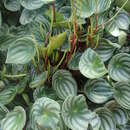tr
kırıntılardaki isimler


Peperomia argyreia, the watermelon peperomia, is a species of flowering plant in the family Piperaceae, native to northern South America, including Bolivia, Brazil, Ecuador, and Venezuela. The plant is not closely related to either watermelons or begonias. These terms relate to the shape, markings and texture of the leaves. Growing to 20 cm (7.9 in) tall and broad, it is a perennial with asymmetrical oval green leaves, slightly fleshy, strikingly marked with curved silver stripes, and red stems. Tiny green flower spikes appear in summer.
The Latin specific epithet argyreia means “silvery”.[1]
This decorative plant is valued in cultivation, and in temperate areas is generally grown as a houseplant at a minimum temperature of 10 °C (50 °F), in bright light but not direct sun. It has gained the Royal Horticultural Society’s Award of Garden Merit.[2][3]
Peperomia argyreia, the watermelon peperomia, is a species of flowering plant in the family Piperaceae, native to northern South America, including Bolivia, Brazil, Ecuador, and Venezuela. The plant is not closely related to either watermelons or begonias. These terms relate to the shape, markings and texture of the leaves. Growing to 20 cm (7.9 in) tall and broad, it is a perennial with asymmetrical oval green leaves, slightly fleshy, strikingly marked with curved silver stripes, and red stems. Tiny green flower spikes appear in summer.
The Latin specific epithet argyreia means “silvery”.
This decorative plant is valued in cultivation, and in temperate areas is generally grown as a houseplant at a minimum temperature of 10 °C (50 °F), in bright light but not direct sun. It has gained the Royal Horticultural Society’s Award of Garden Merit.
Peperomia argyreia, también conocida como meloncito de jardín, peperomia sandía o begonia sandía, es una especie de planta con flores de la familia Piperaceae, originaria de Bolivia, Brasil, Ecuador y Venezuela.
Es una planta herbácea y perenne que crece de forma compacta formando montículos de unos 30 cm de alto y ancho, con hojas coriáceas y redondeadas, pecíolos y tallos de un color rojizo y espigas compactas de flores blancas de entre 8 y 10 cm de largo.[1][2]
Necesita una buena iluminación para su crecimiento, sin llegar a ser expuesta al sol directo ya que puede producirle quemaduras y deshidratación. Es aconsejable un sustrato de humus, grava o arena gruesa y turba, prefiere un ambiente con alta humedad, sobre todo en climas cálidos, pero es sensible al riego excesivo ya que causa pudrición en las raíces. Su rango de temperatura va desde los 16 a los 35 °C, si baja más, los riegos deben ser más espaciados y reducidos, una temperatura baja durante un largo tiempo puede reducir o frenar su crecimiento. Las hojas se pueden limpiar con un paño húmedo, si el aire está muy seco, se pueden pulverizar para mantener la humedad.[3]
Se puede reproducir por medio de esquejes de tallos con al menos tres hojas u hojas individuales con pecíolo, estos se plantan en un sustrato húmedo y se pulverizan para reducir la deshidratación, en unas semanas ya tendrán raíces.
Si el ambiente es muy seco, puede sufrir el ataque de ácaros, esto se puede notar porque las hojas crecen con deformidades y se tornan de un color amarillento, las babosas y caracoles pueden mordisquear o incluso devorar por completo los pecíolos.[4]
Peperomia argyreia, también conocida como meloncito de jardín, peperomia sandía o begonia sandía, es una especie de planta con flores de la familia Piperaceae, originaria de Bolivia, Brasil, Ecuador y Venezuela.
Es una planta herbácea y perenne que crece de forma compacta formando montículos de unos 30 cm de alto y ancho, con hojas coriáceas y redondeadas, pecíolos y tallos de un color rojizo y espigas compactas de flores blancas de entre 8 y 10 cm de largo.
Pépéromia d'argent
Peperomia argyreia, la Pépéromia d'argent, est une espèce de plante herbacée de la famille des pipéracées native de la Bolivie, de l'Argentine, du Brésil et du Venezuela.
Pépéromia d'argent
Peperomia argyreia, la Pépéromia d'argent, est une espèce de plante herbacée de la famille des pipéracées native de la Bolivie, de l'Argentine, du Brésil et du Venezuela.
Peperomia srebrzysta (Peperomia argyreia) – gatunek rośliny z rodziny pieprzowatych. Dawniej nazywana była peperomią Sandersa (Peperomia sandersii). Pochodzi z tropikalnych obszarów Brazylii[3]. W Polsce jest uprawiany jako ozdobna roślina pokojowa.
Jest krzaczastą byliną o wysokości ok. 20 cm. Ma pojedyncze, mięsiste, gładkie, ciemnozielone, szerokoowalne liście o ostrym wierzchołku i długości do 10 cm. Ich charakterystyczną cechą są srebrzyste paski kontrastujące z czerwonymi ogonkami liściowymi o długości do 12 cm[3]. Liście są głównym walorem ozdobnym tej rośliny. Istnieją też kultywary o innych barwach liści.
Gatunek trudny w uprawie, ale przy pewnej wprawie i staraniu możliwy do uprawy w warunkach mieszkaniowych.

Peperomia srebrzysta (Peperomia argyreia) – gatunek rośliny z rodziny pieprzowatych. Dawniej nazywana była peperomią Sandersa (Peperomia sandersii). Pochodzi z tropikalnych obszarów Brazylii. W Polsce jest uprawiany jako ozdobna roślina pokojowa.
Peperomia argyreia là một loài thực vật có hoa trong họ Hồ tiêu. Loài này được (Hook.f.) E.Morren miêu tả khoa học đầu tiên năm 1867.[1]
Peperomia argyreia là một loài thực vật có hoa trong họ Hồ tiêu. Loài này được (Hook.f.) E.Morren miêu tả khoa học đầu tiên năm 1867.